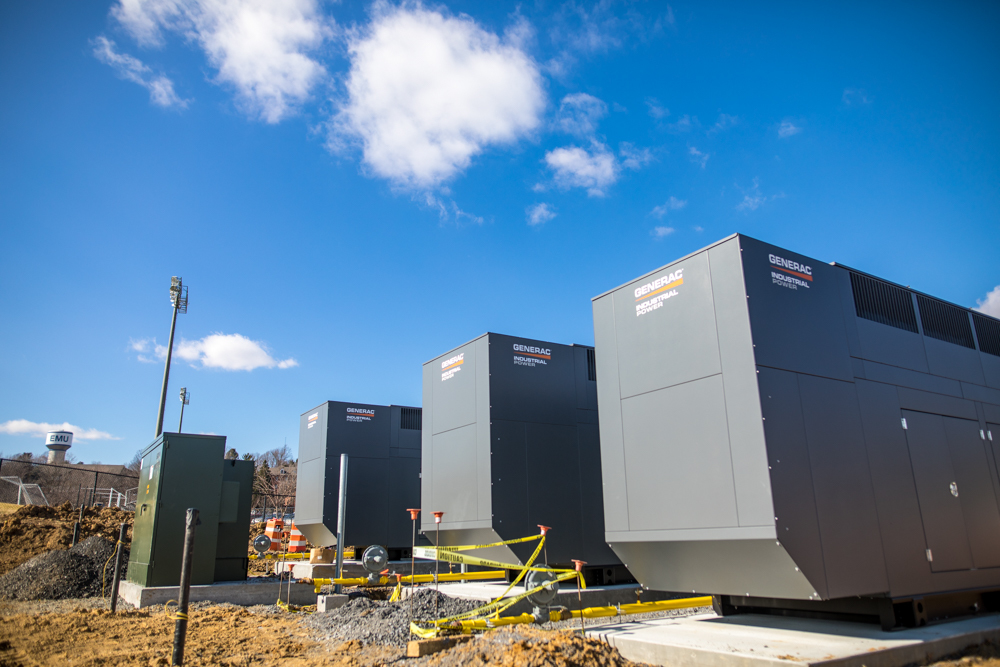With a new microgrid for campus, Eastern Mennonite University is increasing its energy resilience and enhancing its sustainability culture.
The microgrid, set to come online during week of March 12-16, will use three new 500-kilowatt natural gas-fired generators to strengthen EMU’s ability to respond during periods of significant demand on the local grid. It will be able to power the university independently when necessary, such as in times of local grid outages.
“This aligns with the university’s commitment to be an energy-efficient, sustainable campus,” said Ed Lehman, director of facilities management, “and will result in electric utility cost savings for EMU.”
Read more about sustainability and creation care at EMU.
Universities are showing a growing interest in microgrids, said Microgrid Institute founder and director Michael Burr in a Higher Ed Facilities Forum article. Microgrids not only “meet their needs but also showcase their commitment to innovation.”
In the article, EMU’s microgrid was featured as a model among universities such as UC San Diego, MIT, Montclair, Princeton and Santa Clara University that are generating their own power needs.
The facility is projected to save the university almost seven dollars per kilowatt of monthly distribution demand fees.

“We’re taking a load off of Harrisonburg Electric Commission, when they need it, thereby saving them money,” said Lehman. “In turn, they are allowing us to pay a lower distribution demand fee.”
The microgrid was a facility improvement measure stemming from a performance contract with Siemens Building Technologies, which studied EMU’s energy use and made recommendations for improvements. EMU will pay off the improvement measures, including the microgrid generators, over the next 15 years with the savings resulting from improved efficiency and reduced energy and water consumption.
The generators will be integrated into the existing campus building automation system, which already helps manage times of peak electrical demand.
Other steps taken by EMU over the years to improve energy efficiency on campus have included heating system and lighting upgrades, the construction of three LEED Gold-certified buildings and installing 328 high-efficiency photovoltaic panels on the roof of the Hartzler Library. At the time of its installation in 2010, the 104-kilowatt system was the largest in Virginia, and most years it has performed slightly above initial predictions, said Lehman.

So glad to see EMU continue to lead in conservation, innovation and collaboration. Thanks to the entire team who pushed through the challenges to get this project done.
Great, Ed. Keep up good work you all are doing!
Is there any effort to utilize heat produced from these generators? Often a byproduct of electric generation is the need to exhause heat which can easily be a 15% of your energy byproduct. If the heat can be utilized in any way, it can save additional energy.
Denton,
You are right, it would be good if there were a good way to recover some of the heat that is a byproduct of electrical generation from these generators. EMU is interested in and participates in this type of energy recovery/savings whenever it is viable financially. The approved location for the generators is a bit remote in this case to efficiently transfer the heat to where it could be used in a CHP type application. Also, the anticipated generator run time per year would increase the payback period of the heat recovery investment substantially. Thanks for responding. It is good to hear from you and know of your interest in this project.
Good to see EMU doing great steps in conservation and sustantibility.
I’m curious, are there public statistics for the cost and payoff time of this installation? I have to say, it’s disappointing to me to see EMU investing what must be vast sums in what is effectively a natural gas power plant. Aren’t we concerned about climate change? Aren’t we concerned about the theft of indigenous land (Standing Rock), the desolation of farmland, and the iron-fisted rule of energy companies that extract natural gas? Aren’t we concerned about the reality that natural gas producers pour money into the war chests of establishment and particularly right-wing politicians that have no interest in a positive climate future?
This seems like an investment that is locking EMU into an unsustainable and irresponsible power source for decades. Perhaps it’s slightly better than coal-fired Dominion energy, and I’m open to the idea that this could be a money saver, but really, why not more solar?
David,
In response to your final question, there is presently a student-initiated solar project that is being designed and we hope implemented yet this Spring and early Summer that will place additional solar panels on two building roofs. EMU does not have enough real estate or appropriate building roof surface to install solar capability to match the 1500 KW generator capacity of this microgrid project, which is “right-sized” for the electric demand-response function it was designed for, and gives the university power loop a backup power source for those times when the local utility experiences an outage.